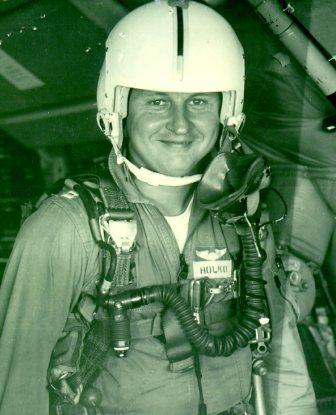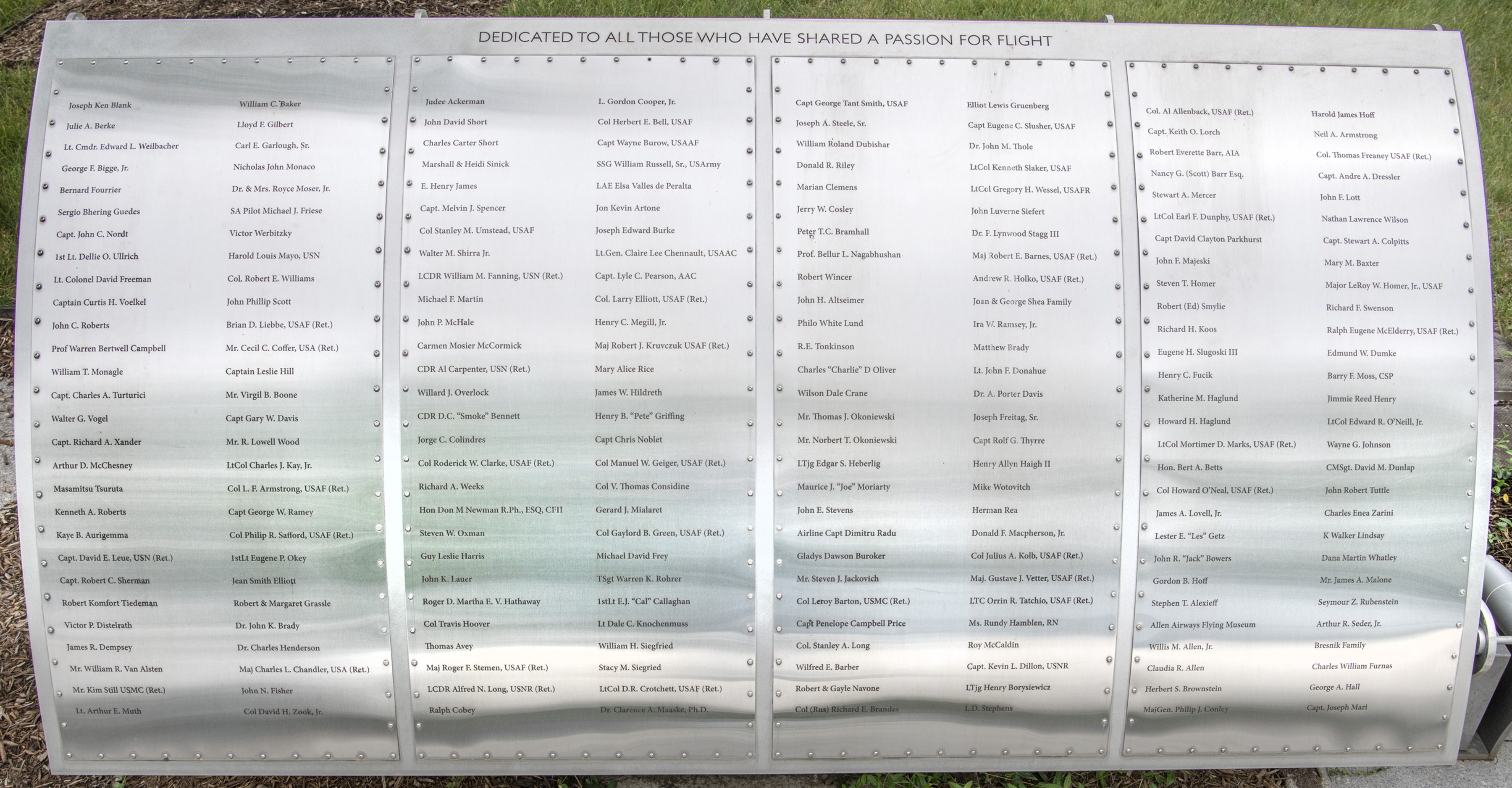
Foil: 23 Panel: 3 Column: 2 Line: 9
Wall of Honor Level: Air and Space Sponsor
Honored by:
Mr. Kurt A. Holko
From my earliest recollections I have been fascinated by things that move through the air, be they insects, birds, leaves, or seed pods, or man-made objects such as kites, balloons, aircraft or even clothes stirring on the clothes line. I love the swirl of wind, the pounding of rain, the beauty of snowstorms, and the sight of clouds blowing across the landscape. I marvel at the power of nature. During my youth, new achievements in science and aviation were many and adventurous people were traveling to points all over the globe. There were writers such as H.G. Wells, and even Buck Rogers comic books were forecasting future space travel. Names like Lindbergh, Doolittle, Earhart, Byrd, Rickenbacker, and many others were constantly in the news. Every child could build a kite or model aircraft and the sound of an engine in the air brought everyone outdoors to look overhead and marvel.
We soon learned those beautiful machines could be used to rain death and destruction on those below and on December 7th, 1941, at Pearl Harbor, our country was plunged into the horror of World War II. For five years this war profoundly affected everyone in the world and most people became familiar with the aircraft of all the warring nations and their capabilities. I always knew I wanted to be a part of aviation and at the age of eight I began my flying career. I constructed a wooden aircraft with a hand carved propeller powered by a two-cylinder Maytag engine, which I launched off of our barn roof. It immediately entered uncontrollable flight and ended up in the top of a large mulberry tree. My father chained it to the tree and there it remained until it weathered away. I attempted no further flight except in day and night dreams. My graduation yearbook from Bristolville High School in 1954 did record my desire to pursue an aviation career in the military.
I began my college years in June 1954 at Kent State University and I entered into the Air Force Reserve Officers Training Corps (ROTC) program as my career path into the Air Force. ROTC training was mostly ground study, drill, and ceremonies but there were opportunities to take a few rides in military aircraft. In my junior year, the Air Force began a flight-training course at the local airport. At last, although it was only a simple Piper Cub, I was flying my own aircraft. I soon had a pilot's license and my family and friends got many thrilling rides, which included my versions of aerobatics, air combat, crop dusting and "scare the farmer." I graduated from Kent in June 1959 with a Bachelor of Arts Degree and a commission as a second lieutenant in the United States Air Force.
In December of 1959 I entered into active duty at Lackland Air Force Base, Texas. There was a one-month course in military customs, procedures and physical and physiological training in preparation for flight school. In January 1960 I arrived at the sleepy southern town of Bainbridge, Georgia for primary flight training. This was a small base contracted by Southern Airlines to the Air Force for flight training. Our civilian flight instructors were mostly ex-military pilots and they were tough. Our ground training was very exacting and our physical training was especially difficult. A sadist named Coach Hardy, who worked us hours under the hot Georgia sun, oversaw physical training. We had as classmates many foreign students from Iran, Norway, Germany and Venezuela. Bainbridge was a real culture shock to us Northern boys who did not know that the South was still a little angry about the Civil War and wanted to get even. At Bainbridge we flew the single engine propeller trainer the T-34 and the twin jet T-37.
After Bainbridge I had a few weeks leave and I returned to Bristolville, Ohio to marry my high school sweet heart. In July 1960 she accompanied me as I headed for Craig Air Force Base in Selma, Alabama, for basic flight training. At Craig Air Force Base the training became intense as we perfected instrument flying, aerobatics, formation and cross-country flight in the Lockheed T-33 Shooting Star, which was a single engine jet trainer. At the end of six months I had my silver pilot's wings and I was ready for my first assignment. At this point we chose our active duty assignments according to class standing. The majority of assignments available were to the Strategic Air Command (SAC) with its bombers and tankers. I chose the KC-97 tanker because I knew it would lead to experience in the KC-135 jet tanker which in turn would have great potential for leading to an airline career. I really did not know much about the KC-97 until I reported to Randolph Air Force Base, Texas, in February 1961 for KC-97 training and saw it for the first time. It was huge and intimidating with four of the world's largest propeller engines at 3500 horsepower each. The cockpit was like a living room and was jammed full with hundreds of controls, gauges and instruments. The fuselage was stacked with fuel tanks and under the aft bottom of the fuselage was the boom pod where the boom-operator laid on his "ironing board" to operate the boom during aerial refueling operations. At the end of KC-97 training in May 1961, 1 reported to the 90th Air Refueling Squadron at Forbes Air Force Base in Topeka, Kansas, for my first duty assignment. The 90th Air Refueling Squadron was engaged in training for the aerial refueling of bombers and fighters and reflex commitments mainly to Goose Bay, Labrador and Frobisher Bay, N.W.T near the North Pole. Our ultimate mission was to refuel nuclear bombers positioned to fly over the pole to bomb targets in the Soviet Union and Eastern Europe.
In June 1962 I was picked by my Squadron Operation Officer to accompany him into KC-135 jet tanker training at Castle Air Force Base, California. The KC-135 was the military version of the Boeing 707 airliner. It was fast, beautiful and state-of-the-art, weighing in at 300,000 pounds when fully loaded with 197,000 pounds of fuel. It could go about halfway around the earth at just under the speed of sound. We completed our training in June 1962 and reported to a dream assignment at McCoy Air Force Base in Orlando, Florida, where I was to remain for seven years. At McCoy the duty involved constant SAC alert tours, numerous tanker task forces all over the world and in 1965 my first tour of duty in the Viet Nam war. In all I spent over a year in South East Asia flying over 200 combat missions earning many decorations and awards. President Thiu and Premier Ky of the Republic of South Vietnam awarded the Vietnamese Air Gallantry medal to me personally.
In June 1969 I left the regular Air Force and took a position with the Pennsylvania Air National Guard based at the Greater Pittsburgh International Airport. This position had a civilian aspect, which was titled "Flight Training and Air Operations Supervisor," and military aspect as "Unit Flight Instructor, Evaluation Pilot and Air Operations Officer". In all cases I wore the uniform and functioned as an Air Force Officer. The unit was first equipped with the C-121 Super Constellation with an aero-medical evacuation mission. The aircraft was equipped and manned as a flying hospital to transport passengers and cargo. Our missions were varied and we flew both stateside and across the world. Later we were assigned the KC-97L, which was an improved version of the old KC-97, and I was then back in the refueling business with the Tactical Air Command. After several more years we were reassigned to the KC-135 E models, which were an improved version of the KC-135 that I had flown in the regular Air Force. We were truly an integral part of the Air Force and we flew missions all over the world. By then I had gained the experience and rank to become a real "Soldier of Fortune" and I became a Task Force Commander in such places as Hawaii, Near East, Alaska, Europe, South and Central America and many other locations. I performed both command and pilot duties in all these locations and I carried
VIPs from many nations to destinations all over the world. I retired from the Air Force in July 1987 with the permanent rank of Lieutenant Colonel and over 9000 military flying hours.
My aviation flying experience extends almost to the present. During my military years I occasionally flew civilian aircraft and in 1985 I purchased a two-seater Wizard T-38 ultra-light. This aircraft was kept on our farm and afforded quite a few enjoyable and occasionally terrifying moments in the air. It could be described as an aluminum chair with wings and an engine. "Vulnerable" is the best word to describe flight in that machine until I sold it in the summer of 2000.
Now I'm back to watching the birds and clouds. I still run outdoors and gaze into the sky when I hear an aircraft engine. My flight suit and helmet are kept handy and I expect to get a call when the Air Force needs a really experienced and hot pilot.
Wall of Honor profiles are provided by the honoree or the donor who added their name to the Wall of Honor. The Museum cannot validate all facts contained in the profiles.
Foil: 23
